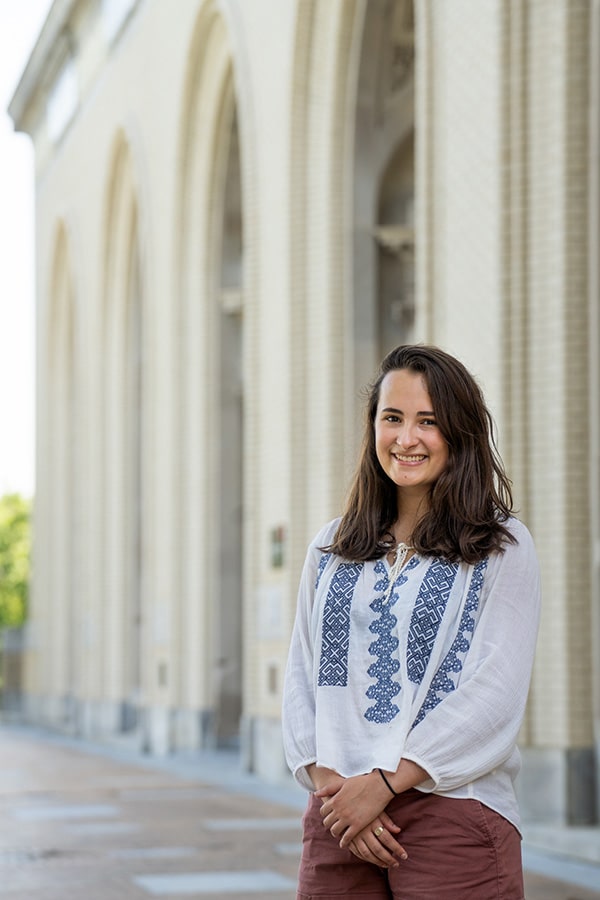Saint Petersburg Mosque, Russia
Kandariya Mahadev Temple, Khajuraho, India
Senior Eyes Using Fractals in Architecture To Reduce Stress
By Julianne Tippett
Media Inquiries- Dietrich College of Humanities and Social Sciences
- 412-268-9309
 Modern architecture is unique for what it is lacking. The clean lines, hard right angles and boxy silhouettes leave little room for detail. Despite the cost-saving benefits of this minimalist approach, it may be having a negative effect on the psyche of urban populations. According to Carnegie Mellon University senior Alice Russell (right), this type of building may even lead to increased stress levels.
Modern architecture is unique for what it is lacking. The clean lines, hard right angles and boxy silhouettes leave little room for detail. Despite the cost-saving benefits of this minimalist approach, it may be having a negative effect on the psyche of urban populations. According to Carnegie Mellon University senior Alice Russell (right), this type of building may even lead to increased stress levels.
Russell is a neuroscience major in the Science and Humanities Scholars program, an interdisciplinary program between the Dietrich College of Humanities and Social Sciences and the Mellon College of Science. She is in the midst of a Dietrich College Honors Fellowship Program project in neuroarchitecture, a field that combines neuroscience and architecture. Her project examines how to design urban environments that can reduce stress.
"This is an amazing project that isn't just about Alice's skill as a researcher but also using science to make wise interventions in the world," said Erik Thiessen, director of Undergraduate Studies and associate professor of psychology. "She has used the pandemic to unfold this project and make it truly mobile and universal to reach the people of Pittsburgh."
Russell's work examines fractals — shapes that repeat at different scales. They are studied widely throughout math and science but also underlie many natural forms. For example, the branches on a tree form their own smaller trunks, creating a tree within a tree within a tree. Another example is a snowflake, which repeats the same pattern over and over extending from a central axis.
People find fractals soothing, Russell said, because the human mind has evolved in nature. Russell landed on the topic of fractal architecture because she was drawn to the idea of incorporating nature's stress relief into architectural design.
"I was first introduced to fractal architecture in Azadeh Sawyer's 'Shaping Daylight' class, a grad-level architecture class, which she graciously let me join as an undergrad neuro major with no architecture training," said Russell. "Fractal architecture is a really promising way to not only optimize things like light, sound and earthquake protection in a building; it also is a scientifically based way of approaching human-centered design."
Previous work in the field supports that nature relieves stress, Russell said, but many modern cities lack adequate green spaces to combat the harsh lines of urban buildings. Troubled by this, she began to research how to incorporate nature into buildings themselves to reduce mental duress common in everyday life.
This is not a new concept, at least not in other cultures. Russell explains how fractal architecture is a common component in Hindu temples, Gothic structures and African architecture.
"[Architecture] almost ties into a culture's view of the universe because fractals have to do with a part of a whole that is also the whole of its parts," said Russell. "Cultures that have that cosmology tend to create more fractal architecture."
Incorporating fractal elements doesn't have to be complex, she said. Fractals can be found in many forms. Even an office space's carpet can increase workplace productivity and reduce stress.
Over the summer Russell conducted an extensive literature review on the science of fractals. By understanding how fractals make people feel, she hopes to use them more effectively in urban designs. She also began working with architectural modeling software to develop the spaces that will be part of a future experiment using a psychology research platform. She has explored this approach in the virtual world and now is venturing into the real world.
"In the process of the literature review and stimuli development, the project really took on a life of its own," said Russell. "It now has multiple branches that deal with fractals in public art as well as architecture, in classroom and urban design and virtual reality."
While much of the project is still in planning stages, data collection is in progress for the public art study. A series of posters designed by Russell invites passengers on Pittsburgh bus lines to answer a survey about their stress levels. Prospective participants will find the posters hanging in bus shelters at Fifth & Chesterfield and Forbes & Craft.
Russell is currently looking for potential collaborators who would like to help her develop virtual reality architecture or paint murals.
Russell's progress on the project can be followed on her blog.
"Alice is an amazing artist and I am blown away by her talent," said Thiessen. "She is using her talent and love of architecture to make the world a better place for all people."